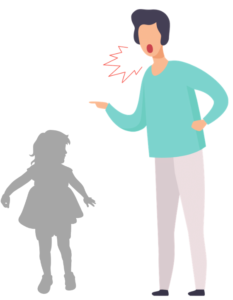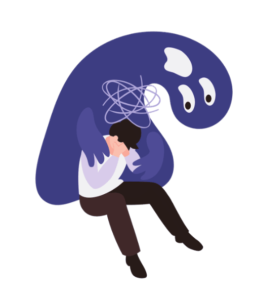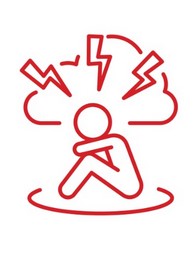What is unprocessed trauma?
PSP are frequently exposed to trauma and may need time to process events that occur during a shift. When PSP transition from work to family life without adequate exit and recovery time to process their experience, they may carry unprocessed trauma. These are the “sticky bits”; an image or a series of events that occurred on-the-job that the PSP cannot stop thinking about. This unprocessed trauma can make it difficult to relax and engage in family activities. The PSP is sometimes unable to leave work behind and may be emotionally distant or irritable. This can impact couple and family relationships. PSP can be physically present but grappling with events from work which interfere with their ability to fully participate in family life.
The effects of unprocessed trauma on PSP families
Try: Skill-building Exercises
Need Something More?
Check out our self-directed Spouse or Significant Other Wellbeing Course.
References for this page (click to expand)
Anderson, L. (2019). The impact of paramedic shift work on the family system: a literature review. British Paramedic Journal, 3(4), 43-43. https://doi.org/10.29045/14784726.2019.03.3.4.43
Beks, T. (2016). Walking on eggshells: the lived experience of partners of Veterans with PTSD. The Qualitative Report 21(4):645-660. https://doi.org/10.46743/2160-3715/2016.2269
Cox, M., Norris, D., Cramm, H., Richmond, R., & Anderson, G. S. (2022). Public safety personnel family resilience: a narrative review. International Journal of Environmental Research and Public Health, 19(9), 5224. https://doi.org/10.3390/ijerph19095224
O’Toole, M., Mulhall, C., & Eppich, W. (2022). Breaking down barriers to help-seeking: preparing first responders’ families for psychological first aid. European Journal of Psychotraumatology, 13(1), 2065430-2065430. https://doi.org/10.1080/20008198.2022.2065430
Porter, K. L., & Henriksen, R. C. (2016). The phenomenological experience of first responder spouses. The Family Journal (Alexandria, Va.), 24(1), 44-51. https://doi.org/10.1177/1066480715615651
Regehr, C., Dimitropoulos, G., Bright, E., George, S., & Henderson, J. (2005). Behind the brotherhood: Rewards and challenges for wives of firefighters. Family Relations, 54(3), 423-435. https://doi.org/10.1111/j.1741-3729.2005.00328.x
Tuttle, B. M., Giano, Z., & Merten, M. J. (2018). Stress spillover in policing and negative relationship functioning for law enforcement marriages. The Family Journal (Alexandria, Va.), 26(2), 246-252. https://doi.org/10.1177/1066480718775739
Good Days and Bad Days
How do negative emotions and reactivity influence home life?
There are consequences when the impact of work stress spills over into family life. Negative emotions can impact how someone engages in family life. It can reduce the quality of family interactions, relationships, and communication.
Withdrawal

If negative emotions lead to withdrawal and disengagement, family members might feel lonely or uncared for. There can be a feeling of loss when the PSP is mentally and emotionally withdrawn from the family. They may be physically present but not actively engaging with the family. This can lead to a loss of intimacy, a loss of relationship, and feelings of frustration and disappointment (see ambiguous loss).
Reactivity

Families may experience reactivity if the PSP family member ‘acts out,’ showing a response that is too ‘over the top’ and not what one would typically expect. Families might feel that the PSP family member loses their temper easily, overreacts to simple things, or makes unreasonable demands. This can lead to emotional fatigue, particularly for spouses and significant others (SSOs).
How do positive emotions and engagement influence home life?
 Positive emotions can support healthy engagement in family/couple life. Relationships and social interactions are enhanced when a PSP family member returns home with a positive outlook. The whole family benefits when all members are able to contribute to complete household tasks and enjoy leisure time together. Engagement and positive interactions build relationships and support the wellbeing of the family. When individuals can show each other respect and kindness, they feel that they are valued members of the family.
Positive emotions can support healthy engagement in family/couple life. Relationships and social interactions are enhanced when a PSP family member returns home with a positive outlook. The whole family benefits when all members are able to contribute to complete household tasks and enjoy leisure time together. Engagement and positive interactions build relationships and support the wellbeing of the family. When individuals can show each other respect and kindness, they feel that they are valued members of the family.
Try: Skill-building Exercises
Need Something More?
Check out our self-directed Spouse or Significant Other Wellbeing Course.
References for this page (click to expand)
American Psychological Association. (2022). APA Dictionary of Psychology. American Psychological Association. Retrieved July 18, 2022, from https://dictionary.apa.org/
Bateman, T. S., & Crant, J. M. (1999). Proactive behavior: Meaning, impact, recommendations. Business Horizons, 42(3), 63–70. https://doi.org/10.1016/S0007-6813(99)80023-8
Brandt, A. (2018). How reactive behavior damages your relationships. Psychology Today. Retrieved August 10, 2022 from https://www.psychologytoday.com/ca/blog/mindful-anger/201810/how-reactive-behavior-damages-your-relationships
Porter, K. L., & Henriksen, R. C. (2016). The phenomenological experience of first responder spouses. The Family Journal (Alexandria, Va.), 24(1), 44-51. https://doi.org/10.1177/1066480715615651
Regehr, C. (2005). Bringing the trauma home: Spouses of paramedics. Journal of Loss & Trauma, 10(2), 97-114. https://doi.org/10.1080/15325020590908812
Regehr, C., Dimitropoulos, G., Bright, E., George, S., & Henderson, J. (2005). Behind the brotherhood: Rewards and challenges for wives of firefighters. Family Relations, 54(3), 423-435. https://doi.org/10.1111/j.1741-3729.2005.00328.x
Sonnentag, S., & Binnewies, C. (2013). Daily affect spillover from work to home: Detachment from work and sleep as moderators. Journal of Vocational Behavior, 83(2), 198-208. https://doi.org/10.1016/j.jvb.2013.03.008
Tuttle, B. M., Giano, Z., & Merten, M. J. (2018). Stress spillover in policing and negative relationship functioning for law enforcement marriages. The Family Journal (Alexandria, Va.), 26(2), 246-252. https://doi.org/10.1177/1066480718775739
Indirect trauma exposure
PSP and PSP families can experience direct exposure to trauma by experiencing, witnessing, confronting, or being involved in a traumatic event. Over time, repeated exposure to details of a traumatic event can also impact PSP families. This is called indirect exposure and is sometimes referred to as vicarious trauma and/or secondary trauma. There are some differences between vicarious and secondary trauma. Vicarious trauma occurs over time and can change how a person sees the world. The person with secondary trauma experiences trauma-related symptoms in response to another person’s trauma.
Difference between vicarious and secondary trauma
Vicarious trauma

- comes with a lasting change in worldview through an empathic relationship
- can develop as an accumulation of hearing about several traumas over time
- can include affective and cognitive changes, such as alterations in self-identity and mental health
Secondary trauma

- involves experiencing trauma-related symptoms in response to another’s trauma
- can happen as a response to a single event
- can lead to manifestation of PTSD symptoms among contacts of traumatized individuals, including family members
Examples of Vicarious and Secondary Trauma
Effects of indirect trauma on family members
SSOs and other family members who are indirectly exposed to details about serious traumatic events can be affected. When SSOs and family members become “sounding boards” and learn about traumatic events through PSP family member, they are at risk of indirect trauma.
The effects of indirect trauma on spouses and significant others (SSOs):

- Discomfort and anxiety – SSOs can feel discomfort and anxiety when PSPs share details of incidents with them. It affects their perception of safety and trust and may change their worldview.
- Withdrawal – Those experiencing indirect trauma may withdraw from others and feel a sense of hopelessness and helplessness. It can affect the person’s sense of identity and negatively impact relationships with family, friends, and co-workers. For more information on avoidance/withdrawal behaviours (see ambigious loss).
- Physical symptoms – The trauma experienced by PSP can be internalized by SSOs through their effort to help the PSP. This can result in physical symptoms such as nausea, headaches, fatigue, and confusion. SSOs can also experience posttraumatic stress symptoms, including avoidance and hyperarousal.
- Compassion fatigue – Compassion fatigue can arise through empathy and taking on a caregiving role. Those who live with someone who has developed PTSD are at higher risk. Emotional numbness is a symptom of compassion fatigue.
The effects of indirect trauma on children:

Studies of military families indicate that children are at risk for mental health challenges when a parent is living with an operational stress injury (OSI). These include emotional and social problems as well as learning difficulties.456 Military children have been found to imitate their parent’s PTSD symptoms (secondary trauma).
Children of PSP have been found to be susceptible to developing separation anxiety disorder.7 Children of traumatized first responders also at risk of developing posttraumatic stress symptoms through secondary trauma. The psychological functioning of parents is related to their children’s mental health and wellbeing.8
Positive effects of indirect trauma
Exposure to PSP’s trauma may also result in:
Postraumatic growth

Posttraumatic growth (PTG) occurs when an individual experiences a positive psychological change after exposure to major trauma or life crisis.
Hearing about someone else’s trauma can lead an individual to develop more positive views on human resilience, including amazement at the human spirit.
This can result in positive changes, including learning to be more compassionate, becoming more accepting of others, and gaining a greater appreciation for life itself.
Vicarious resilience

Vicarious resilience occurs when those indirectly affected by trauma are positively influenced by the resilience of someone who was directly affected. Resilience is often demonstrated through that person’s journey and recovery process.
Vicarious resilience can include positive meaning making and growth through the vicarious experience of someone else’s journey through trauma.
Try: Skill-building Exercises
Need Something More?
Check out our self-directed Spouse or Significant Other Wellbeing Course.
References for this page (click to expand)
1Porter, K. L., & Henriksen, R. C. (2016). The phenomenological experience of first responder spouses. The Family Journal (Alexandria, Va.), 24(1), 44-51. https://doi.org/10.1177/1066480715615651
2Regehr, C. (2005). Bringing the trauma home: Spouses of paramedics. Journal of Loss & Trauma, 10(2), 97-114. https://doi.org/10.1080/15325020590908812
3Cramm, H., Tam-Seto, L., Norris, D., Eichler, M., & Smith-Evans, K. (2016). The impact of parental operational stress injury on child mental health and well-being: A scoping review. Military Behavioral Health, 4(4), 334-344. https://doi.org/10.1080/21635781.2016.1181582
4Dinshtein, Y., Dekel, R., & Polliack, M. (2011). Secondary traumatization among adult children of ptsd veterans: The role of mother-child relationships. Journal of Family Social Work, 14(2), 109-124. https://doi.org/10.1080/10522158.2011.544021
5Kishon, R., Geronazzo-Alman, L., Teichman, M., Teichman, Y., Cheslack-Postava, K., Fan, B., Duarte, C. S., Wicks, J., Musa, G. J., Djalovski, A., Tadmor, B., Moreno, D. R., Cycowicz, Y., Amsel, L., Bresnahan, M., & Hoven, C. W. (2020). Parental occupational exposure is associated with their childrenʼs psychopathology: A study of families of Israeli first responders. Journal of Occupational and Environmental Medicine, 62(11), 904-915. https://doi.org/10.1097/JOM.0000000000001971
Alrutz, A. S., Buetow, S., Cameron, L. D., & Huggard, P. K. (2020). What happens at work comes home. Healthcare (Basel), 8(3), 350. https://doi.org/10.3390/healthcare8030350
Cohen, K., & Collens, P. (2013). The impact of trauma work on trauma workers: A metasynthesis on vicarious trauma and vicarious posttraumatic growth. Psychological Trauma, 5(6), 570-580. https://doi.org/10.1037/a0030388
Duarte, C. S., Eisenberg, R., Musa, G. J., Addolorato, A., Shen, S., & Hoven, C. W. (2017). Children’s knowledge about parental exposure to trauma. Journal of Child & Adolescent Trauma, 12(1), 31-35. https://doi.org/10.1007/s40653-017-0159-7
Friese, K. M. (2020). Cuffed together: A study on how law enforcement work impacts the officer’s spouse. International Journal of Police Science & Management, 22(4), 407-418. https://doi.org/10.1177/1461355720962527
Hernandez-Wolfe, P., Killian, K., Engstrom, D., & Gangsei, D. (2015). Vicarious resilience, vicarious trauma, and awareness of equity in trauma work. The Journal of Humanistic Psychology, 55(2), 153-172. https://doi.org/10.1177/0022167814534322
Hoven, C. W., Duarte, C. S., Wu, P., Doan, T., Singh, N., Mandell, D. J., Bin, F., Teichman, Y., Teichman, M., Wicks, J., Musa, G., & Cohen, P. (2009). Parental exposure to mass violence and child mental health: The first responder and WTC evacuee study. Clinical Child and Family Psychology Review, 12(2), 95-112. https://doi.org/10.1007/s10567-009-0047-2
Landers, A. L., Dimitropoulos, G., Mendenhall, T. J., Kennedy, A., & Zemanek, L. (2020). Backing the blue: Trauma in law enforcement spouses and couples. Family Relations, 69(2), 308-319. https://doi.org/10.1111/fare.12393
Meffert, S. M., Henn-Haase, C., Metzler, T. J., Qian, M., Best, S., Hirschfeld, A., McCaslin, S., Inslicht, S., Neylan, T. C., & Marmar, C. R. (2014). Prospective study of police officer spouse/partners: A new pathway to secondary trauma and relationship violence? PloS One, 9(7), e100663-e100663. https://doi.org/10.1371/journal.pone.0100663
Posttraumatic Stress Injury (PTSI)
Posttraumatic Stress Injury (PTSI) is a term used within military and PSP communities in Canada. It “refers to a mental health condition that a person acquires as a result of exposure to one or more potentially traumatic events” (CIPSRT, 2020). It is a term preferred by some people to describe those symptoms commonly diagnosed as Posttraumatic Stress Disorder (PTSD). A distinction is made between an “injury” resulting from a traumatic exposure and a “disorder” which is often associated with stigma. For PSP, PTSI can happen at any time. PTSI may become more evident later in a career due to a buildup of exposures over time. PSP family members can be impacted by the PSP’s experience with trauma as well as their own traumatic experiences (direct events that occur independent of the PSP).
Criteria for PTSD
Exposure: 
- Being directly exposed to an potentially traumatic event.
- Witnessing a potentially traumatic event that occurs to others.
- Learning about a potentially traumatic event that occurs to others.
- Experiencing repeated exposure to details of a potentially traumatic event.
Symptoms (lasting more than one month)
- Intrusive symptoms: recurring, involuntary, and distressing memories of a traumatic event; recurring nightmares and/or flashbacks.
- Avoidance: attempts to avoid distressing memories, thoughts, or feelings associated with the event (e.g., avoiding people, places, situations).
- Mood changes: persistent negative thoughts, lack of interest in activities, inability to experience positive emotions, and/or feeling detached.
- Reactivity: irritability, self-destructive behaviour, hypervigilance, exaggerated startle response, poor concentration, and/or disturbed sleep).
Stigma around Posttraumatic Stress Injury (PTSI) in PSP sectors

Some PSP might find it hard or hesitate to seek help for mental health concerns. This can be because of stigma, perceived stigma, or self-stigma around mental illness. Stigma describes the negative attitudes and perceptions around mental illness. Much work is being done to dispel the myth that mental illness is a weakness.
Because of their roles, PSP are often presumed to be strong and courageous in all that they do. There might be a feeling that they are letting the team and community down if PSP seek mental health support. Many PSP have reported feeling this expectation of courage and strength, and so fear the labels that might come with seeking support. PSP also fear that seeking mental health support could have an impact on their jobs.
When stigma prevents PSP from seeking out care, it increases the strain placed on other family members. They may have to cope with behavioural changes in the PSP and an increase in household responsibilities because the PSP is unable or unwilling to contribute. The stigma can also lead to isolation for both the PSP and family members. PSP might be afraid that others will not accept or trust them or will think less of them. They may avoid going out and, in turn, reduce chances for their families to socialize with extended family and friends.
Effects of PTSI on PSP Families
Try: Skill-building Exercises
Need Something More?
Check out our self-directed Spouse or Significant Other Wellbeing Course.
References for this page (click to expand)
American Psychiatric Association. (2013). Diagnostic and statistical manual of mental disorders (5th ed.). https://doi.org/10.1176/appi.books.9780890425596
Carleton, R. N., Afifi, T. O., Turner, S., Taillieu, T., Duranceau, S., LeBouthillier, D. M., Sareen, J., Ricciardelli, R., MacPhee, R. S., Groll, D., Hozempa, K., Brunet, A., Weekes, J. R., Griffiths, C. T., Abrams, K. J., Jones, N. A., Beshai, S., Cramm, H. A., Dobson, K. S., Hatcher, S., … Asmundson, G. J. G. (2018). Mental disorder symptoms among public safety personnel in Canada. Canadian journal of psychiatry. Revue canadienne de psychiatrie, 63(1), 54–64. https://doi.org/10.1177/0706743717723825
CIPSRT (2020). Glossary of terms. https://www.cipsrt-icrtsp.ca/en/resources/glossary-of-terms#661
Corrigan, P. W., Druss, B. G., & Perlick, D. A. (2014). The impact of mental illness stigma on seeking and participating in mental health care. Psychological Science in the Public Interest : A Journal of the American Psychological Society, 15(2), 37–70. https://doi.org/10.1177/1529100614531398
Jones, S., Agud, K. & McSweeney, J. (2019). Barriers and facilitators to seeking mental health care among first responders: “Removing the Darkness”. Journal of the American Psychiatric Nurses Association 26(1):43-54. https://doi.org/10.1177/1078390319871997
Lewis-Schroeder, N. F., Kieran, K., Murphy, B. L., Wolff, J. D., Robinson, M. A. & Kaufman, M. L. (2018). Conceptualization, assessment, and treatment of traumatic stress in first responders: A review of critical issues. Harvard review of psychiatry, 26(4), 216–227. https://doi.org/10.1097/HRP.0000000000000176
McKeon, G., Wells, R., Steel, Z., Moseley, V. & Rosenbaum, S. (2020). Self-reported physical and mental health of informal caregivers of emergency service workers. Journal of Loss and Trauma, 26(6), 507-518. https://doi.org/10.1080/15325024.2020.1845020
O’Toole, M., Mulhall, C., & Eppich, W. (2022). Breaking down barriers to help-seeking: preparing first responders’ families for psychological first aid. European Journal of Psychotraumatology, 13(1), 2065430-2065430. https://doi.org/10.1080/20008198.2022.2065430
Porter, K. L., & Henriksen, R. C. (2016). The phenomenological experience of first responder spouses. The Family Journal (Alexandria, Va.), 24(1), 44-51. https://doi.org/10.1177/1066480715615651
Public Safety Canada. (2022). Supporting Canada’s Public Safety Personnel: An Action Plan on Post-traumatic Stress Injuries. Retrieved August 29, 2022 from https://www.publicsafety.gc.ca/cnt/rsrcs/pblctns/2019-ctn-pln-ptsi/index-en.aspx
Shepherd-Banigan, M., Shapiro, B., McDuffie, J. R., Brancu, M., Sperber, N. R., Van Houtven, C. H., Kosinski, A. S., Mehta, N. N., Nagi, A. & Williams, J. W. (2018). Interventions that support or involve caregivers or families of patients with traumatic injury: A systematic review. Journal of General Internal Medicine, 33(7):1177-1186. https://doi.org/10.1007/s11606-018-4417-7
Thomson, J. L. (2021). PTSD perceptions in the U.S. military members and their families: A qualitative study. SAGE Open, 11(1). https://doi.org/10.1177/21582440211006393
Wyse, J. J., Ono, S. S., Kabat, M. & True, G. (2020). Supporting family caregivers of Veterans: Participant perceptions of a federally-mandated caregiver support program. Healthcare (Amsterdam, Netherlands), 8(3), 100441. https://doi.org/10.1016/j.hjdsi.2020.100441
Ambiguous loss
Click on the arrows below to learn more:
Avoidant behaviours
After exposure to a stressful event, those affected may try to avoid related emotions. This is how they cope with trauma. A person might immerse themselves in an activity, shut down, or engage in substance abuse to escape their feelings. These are avoidant behaviours. People affected by trauma might also respond by withdrawing from family and friends. They might spend more time alone and turn down opportunities to socialize. Withdrawal behaviours include irritability, reduced communication, and limited involvement in family life. When a family member is not really “there”, a source of emotional and practical support is lost for families.
Impacts of “not thereness” on families

When substance use, gambling, infidelity, or other vices are used to cope with trauma, SSOs can experience sadness, anger, jealousy, and/or depression. Poor communication can put the couple relationship at risk. Developing healthier strategies to manage trauma exposure can reduce the risks for families.

Over time, PSP families report that they have learned the signs of a ‘bad call.’ They know what to pay attention to and adjust their expectations. Sometimes these behaviours are isolated and manageable. Repeated behaviours that disrupt family life may require the support of a mental health professional.

When PSP withdraw from family life, family members, especially SSOs, are burdened with added responsibilities. More demands on any family member’s time can lead to role overload. The wellbeing of the family depends on timely and effective strategies that support healthy outcomes for all family members.

Both physical and emotional distance and the unpredictable involvement of a family member in family life strain relationships. Family members can experience feelings of anger and resentment, which can arise from lack of intimacy and trust. Early intervention is important to prevent growing problems.
Try: Skill-building Exercises
Need Something More?
Check out our self-directed Spouse or Significant Other Wellbeing Course.
References for this page (click to expand)
Beks, T. (2016). Walking on eggshells: the lived experience of partners of Veterans with PTSD. The Qualitative Report 21(4):645-660. https://doi.org/10.46743/2160-3715/2016.2269
Boss, P. (1992). Primacy of perception in family stress theory and measurement. Journal of Family Psychology, 6(2), 113-119. https://doi.org/10.1037/0893-3200.6.2.113
Dekel, R., Levinstein, Y., Siegel, A., Fridkin, S., & Svetlitzky, V. (2016). Secondary traumatization of partners of war veterans: the role of boundary ambiguity. Journal of Family Psychology, 30(1), 63-71. https://doi.org/10.1037/fam0000163
Miller, L. (2007). Police families: Stresses, syndromes, and solutions. The American Journal of Family Therapy, 35(1), 21-40. https://doi.org/10.1080/01926180600698541
Porter, K. L., & Henriksen, R. C. (2016). The phenomenological experience of first responder spouses. The Family Journal (Alexandria, Va.), 24(1), 44-51. https://doi.org/10.1177/1066480715615651
Regehr, C., Dimitropoulos, G., Bright, E., George, S., & Henderson, J. (2005). Behind the brotherhood: Rewards and challenges for wives of firefighters. Family Relations, 54(3), 423-435. https://doi.org/10.1111/j.1741-3729.2005.00328.x
Taft, C. T., Watkins, L. E., Stafford, J., Street, A. E., & Monson, C. M. (2011). Posttraumatic stress disorder and intimate relationship problems: a meta-analysis. Journal of Consulting and Clinical Psychology, 79(1), 22.
Waddell, E., Lawn, S., Roberts, L., Henderson, J., Venning, A., & Redpath, P. (2020). “Why do you stay?”: The lived‐experience of partners of Australian veterans and first responders with Posttraumatic Stress Disorder. Health & Social Care in the Community, 28(5), 1734-1742. https://doi.org/10.1111/hsc.12998
Watkins, S. L., Shannon, M. A., Hurtado, D. A., Shea, S. A., & Bowles, N. P. (2021). Interactions between home, work, and sleep among firefighters. American Journal of Industrial Medicine, 64(2), 137-148. https://doi.org/10.1002/ajim.23194





